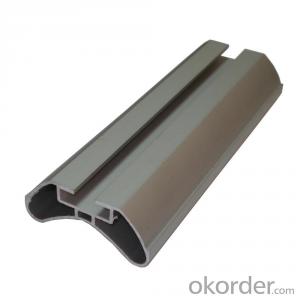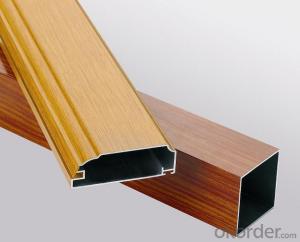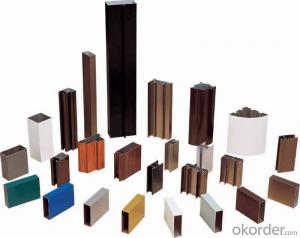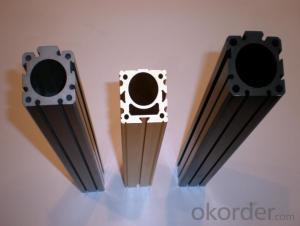Manufacturing aluminium profile
- Loading Port:
- China Main Port
- Payment Terms:
- TT OR LC
- Min Order Qty:
- -
- Supply Capability:
- -
OKorder Service Pledge
Quality Product, Order Online Tracking, Timely Delivery
OKorder Financial Service
Credit Rating, Credit Services, Credit Purchasing
You Might Also Like
Aluminium profile
1) Alloy: AA6061, AA6063
2) Temper: T5, T6
3) Series of surface treament:
1. Mill Finished
2. Anodizing: Silver, champagne, light bronze, dark bronze, black, light titanium, dark titanium.
3. Electrophoretic Coating: Silver, champagne, bronze, black, light bronze, dark bronze.
4. Electrostatic Color Powder Coating: Normal color, special color.
5. Fluorocarbon Powder Spraying: Normal color, special color.
6. Wood Grain Coating: Import paper, domestic paper.

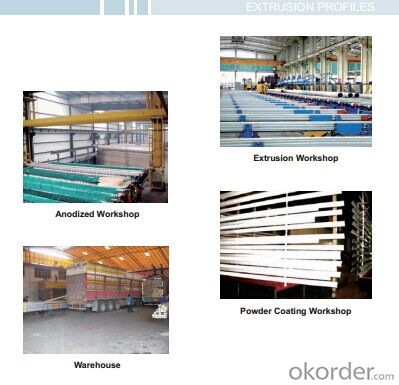
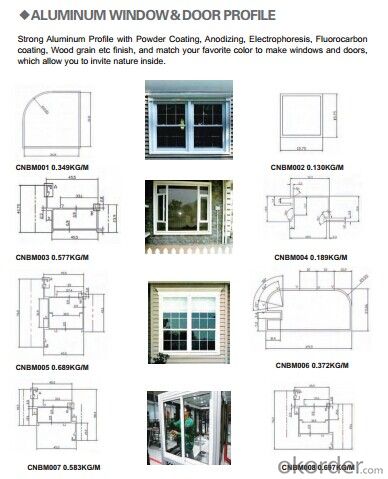
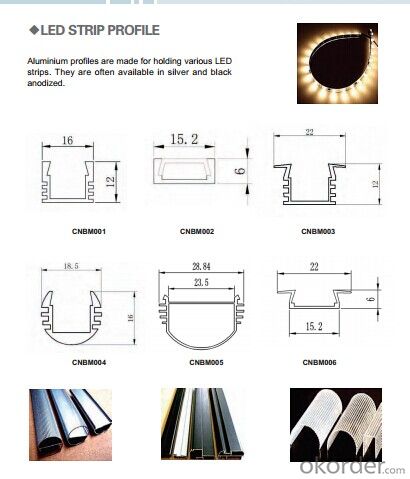

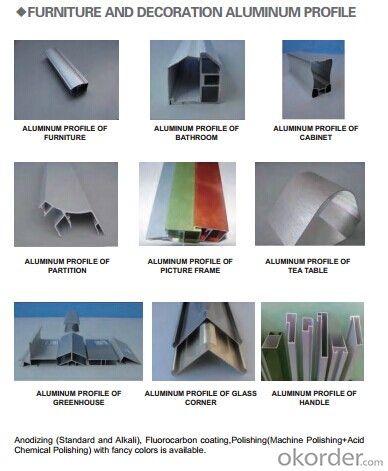
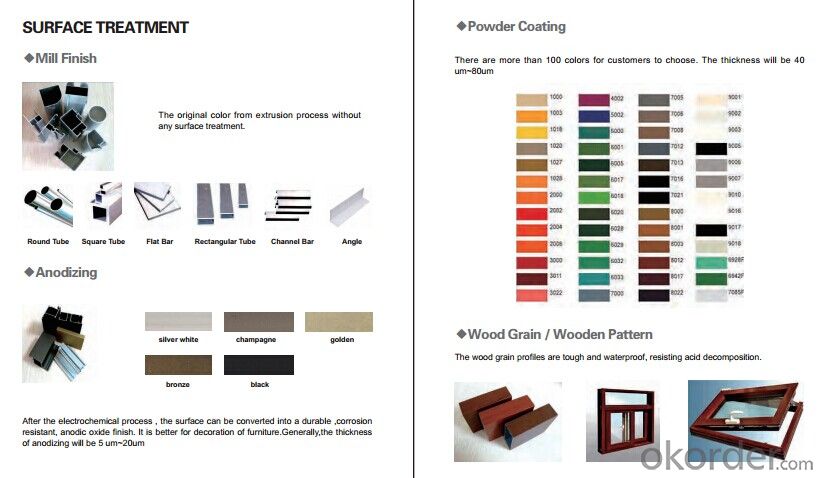
- Q:The latest list of aluminum China
- The first aluminum aluminum (China Aluminum Group, the central management of large state-owned enterprises)Second of Asia Aluminum (Asia Aluminum Group, Asia's largest aluminum producer, Chinese brand)Third strong aluminum products (China famous brand, national inspection free products)Fourth (Chinese Fenglv aluminum material brand, national Mianjian products)Fifth Zhong Zhong aluminum (China famous brand, China well-known trademark, national inspection free products)Sixth (Chinese Hing Fat aluminum brand, A Well-Known Trademark in China, national Mianjian products)Seventh South Asia Aluminum profiles (China famous brand, national inspection free products)Eighth Nanshan aluminum (China famous brand, China well-known trademark, national inspection free products)Ninth by court aluminum profiles (China well-known trademarks, national inspection free products)Albert tenth aluminum (China famous brand, national inspection free products)
- Q:The surface of pure aluminum is relatively soft, too hard to be machined, and the other to be polished. If you want to harden the aluminum parts you produce. What's the way?. Please expert pointing
- anodic oxidation6063 is not pure aluminum, in order to harden can consider aging, aluminum extrusions mainly through air-cooled quenching and aging to achieve T5 processingOn the surface, several um thickness alumina protective layers can be formed to improve corrosion resistance and wear resistance. In addition, if you can change materials, you can choose 2024T4 (Ying Lv).
- Q:The aluminum and Fenglv aluminum material which is better suited for doors and windows
- Al Feng is one of the ten famous material, certainly no problem. But Feng packaging is too thick, high cost. To do the doors and windows of the aluminum used to choose cost-effective, as a special material for the sale of aluminum, I have the following recommendations: 1. The window wheel is good, and the pressed glass should be durable and corrosion resistant. 2. doors and windows sealing performance better, 3. pages to be matched with materials, gauze or rust, and thickness and density better than 4. The cost performance is high, the surface treatment layer of the profile is electrophoresis, and the electrophoresis layer should be thick. 5. The mounting frame needs to be hit to the horizontal line.
- Q:What are the different cutting options available for aluminum profiles?
- There are several cutting options available for aluminum profiles, depending on the specific requirements of the project. Some of the common cutting methods include: 1. Miter Saw: This is a popular cutting option for aluminum profiles. A miter saw uses a circular blade to make precise angled cuts, allowing for accurate and clean cuts on aluminum profiles. 2. Chop Saw: Similar to a miter saw, a chop saw is also commonly used for cutting aluminum profiles. It uses a circular blade to make straight cuts at 90-degree angles. It is efficient and can handle larger aluminum profiles with ease. 3. Bandsaw: A bandsaw is another versatile cutting option for aluminum profiles. It uses a continuous looped blade to make straight cuts. It provides more flexibility in terms of cutting angles and is capable of cutting thicker aluminum profiles. 4. CNC Cutting: Computer Numerical Control (CNC) cutting is a highly accurate and precise cutting method for aluminum profiles. It involves using a computer-controlled cutting machine that can follow complex design patterns. This method is ideal for intricate and detailed cuts, ensuring high precision and repeatability. 5. Laser Cutting: Laser cutting is a popular cutting option for aluminum profiles as it offers a high level of precision and clean cuts. It involves using a focused laser beam to melt or vaporize the aluminum, resulting in smooth and accurate cuts. Laser cutting is suitable for both simple and complex designs. 6. Waterjet Cutting: Waterjet cutting is a versatile cutting method that uses a high-pressure jet of water mixed with abrasive particles to cut through aluminum profiles. It can handle various thicknesses and shapes, providing precise cuts without generating heat or altering the properties of the aluminum. 7. Shearing: Shearing is a basic cutting method that involves using sharp blades to trim or cut aluminum profiles. It is commonly used for straight cuts and is suitable for thinner aluminum profiles. 8. Plasma Cutting: Plasma cutting uses a high-velocity jet of ionized gas to cut through aluminum profiles. It is suitable for thicker profiles and allows for faster cutting speeds compared to other methods. These are just some of the cutting options available for aluminum profiles. The choice of method depends on factors such as the desired cut type, accuracy requirements, profile thickness, and complexity of the design. It is important to consider these factors and consult with professionals to determine the most suitable cutting option for a specific project.
- Q:Which aluminum profile is better here in Guangdong?
- 1 、 aluminum material2, Zhong Wang aluminum3 Asia Aluminum4, Hing Fat aluminum5, the phoenix aluminum aluminum6, the United States and aluminum7, vibration or aluminum8 、 Nanshan aluminum material9, pillars of aluminum10, South South aluminum
- Q:Can aluminum profiles be an alternative to wood in construction?
- Indeed, aluminum profiles have the potential to serve as a practical substitute for wood in the field of construction. Numerous advantages are associated with aluminum profiles, rendering them a favored choice in numerous construction projects. To begin with, aluminum profiles possess the dual qualities of being lightweight and robust, making them easily manageable and installable. This characteristic renders them suitable for a wide array of applications, including the creation of door and window frames, curtain walls, and partitions. Furthermore, aluminum profiles exhibit exceptional durability and resistance to weathering, corrosion, and pests, thereby ensuring a long-lasting and low-maintenance alternative. Moreover, aluminum profiles possess inherent fire-resistant properties, which can greatly enhance safety during the construction process. Unlike wood, aluminum does not burn, and boasts a high melting point, thereby reducing the likelihood of its contribution to the spread of fires. From an environmental standpoint, aluminum profiles offer a multitude of benefits. Aluminum is an eminently recyclable material, allowing for its repeated use and repurposing without compromising its inherent properties. This recyclability minimizes the environmental impact associated with construction projects and supports the concept of a circular economy. Furthermore, the design versatility of aluminum profiles is a distinct advantage. Aluminum can be easily shaped and extruded into various profiles and sizes, thereby enabling customization and flexibility in architectural designs. This adaptability renders aluminum profiles suitable for both functional and aesthetic purposes within the realm of construction. Nevertheless, it is vital to acknowledge that aluminum profiles may incur higher initial costs in comparison to wood. Additionally, aluminum possesses a higher thermal conductivity than wood, necessitating additional insulation to ensure optimal thermal performance. To conclude, due to their lightweight nature, durability, fire resistance, sustainability, and design versatility, aluminum profiles can serve as a viable alternative to wood in the field of construction. Though there may be certain considerations regarding cost and thermal conductivity, the numerous advantages of aluminum profiles make them an attractive option for a wide range of construction applications.
- Q:Are aluminum profiles suitable for partition walls?
- Partition walls can indeed be constructed using aluminum profiles. Aluminum, a material known for its lightweight and durability, is frequently utilized in the construction industry because of its versatility and strength. It offers exceptional structural support and can be easily tailored to meet diverse design specifications. Moreover, aluminum profiles provide a sleek and contemporary appearance, rendering them highly sought after for modern interior designs. Furthermore, aluminum is resistant to corrosion and necessitates minimal upkeep, making it a cost-effective alternative for partition walls. In conclusion, aluminum profiles are a dependable and pragmatic option for producing robust and visually appealing partition walls.
- Q:Can aluminum profiles be used in the construction of green buildings?
- Yes, aluminum profiles can definitely be used in the construction of green buildings. Aluminum is a highly sustainable material that offers numerous benefits for green building projects. Firstly, aluminum is a lightweight material, making it easier to transport and handle during construction. This leads to reduced energy consumption and carbon emissions in transportation. Secondly, aluminum is highly recyclable. It can be melted down and reused without any loss in quality, making it a perfect choice for sustainable construction. This recyclability also reduces the demand for extracting and processing new aluminum, further reducing the environmental impact. Additionally, aluminum has excellent durability and corrosion resistance, which means it can last for a long time without requiring frequent maintenance or replacement. This reduces the need for new materials and reduces waste over the building's lifespan. Furthermore, aluminum profiles can be designed to enhance energy efficiency in green buildings. They can be used for windows, doors, and curtain walls, providing excellent thermal insulation and minimizing heat loss or gain. This reduces the energy consumption required for heating or cooling the building, resulting in lower carbon emissions. Moreover, aluminum is a non-toxic material and does not release harmful chemicals into the environment, ensuring a healthier indoor environment for occupants. In conclusion, aluminum profiles offer numerous advantages for green building construction. Their lightweight nature, recyclability, durability, energy efficiency, and non-toxicity make them a sustainable choice for green building projects.
- Q:Excuse me, aluminum oxidation and electrophoresis have what different?
- Alumina:The substrate is used as an anode to be electrolyzed in an electrolyte, and a protective oxide film is formed on the surface of the substrate artificially so as to form an oxidized aluminum materialMain features of aluminium oxide material:1. It has strong wear resistance, weather resistance and corrosion resistance2, you can form a variety of colors on the substrate surface, the maximum to suit your requirements3, hardness is strong, suitable for all kinds of building, industrial material production
- Q:How do I maintain and clean aluminum profiles?
- To maintain and clean aluminum profiles, there are a few steps you can follow: 1. Regular dusting: Start by removing any loose dust or dirt using a soft cloth or a feather duster. This will prevent the build-up of grime and make the cleaning process easier. 2. Prepare a cleaning solution: Mix a mild detergent or dish soap with warm water in a bucket or a spray bottle. Avoid using harsh chemicals or abrasive cleaners as they can damage the aluminum surface. 3. Wipe down the profiles: Dip a soft cloth or sponge into the cleaning solution and gently scrub the aluminum profiles. Pay special attention to any areas with stains or stubborn dirt. 4. Rinse with clean water: After cleaning, rinse the profiles thoroughly with clean water to remove any residual soap or cleaning solution. This step is crucial to prevent any residue from drying and leaving streaks or marks. 5. Dry the profiles: Use a soft, dry cloth or towel to wipe the aluminum profiles dry. This will help prevent water spots and maintain the shine of the metal. 6. Polish (optional): If desired, you can apply a non-abrasive aluminum polish to further enhance the shine and protect the surface. Follow the instructions on the polish packaging for best results. 7. Regular maintenance: To keep the aluminum profiles in good condition, it is essential to perform regular maintenance. This includes dusting them regularly, avoiding abrasive materials or cleaners, and addressing any stains or spills promptly. By following these steps, you can maintain and clean aluminum profiles effectively, keeping them looking great for longer periods.
1. Manufacturer Overview |
|
|---|---|
| Location | |
| Year Established | |
| Annual Output Value | |
| Main Markets | |
| Company Certifications | |
2. Manufacturer Certificates |
|
|---|---|
| a) Certification Name | |
| Range | |
| Reference | |
| Validity Period | |
3. Manufacturer Capability |
|
|---|---|
| a)Trade Capacity | |
| Nearest Port | |
| Export Percentage | |
| No.of Employees in Trade Department | |
| Language Spoken: | |
| b)Factory Information | |
| Factory Size: | |
| No. of Production Lines | |
| Contract Manufacturing | |
| Product Price Range | |
Send your message to us
Manufacturing aluminium profile
- Loading Port:
- China Main Port
- Payment Terms:
- TT OR LC
- Min Order Qty:
- -
- Supply Capability:
- -
OKorder Service Pledge
Quality Product, Order Online Tracking, Timely Delivery
OKorder Financial Service
Credit Rating, Credit Services, Credit Purchasing
Similar products
New products
Hot products
Related keywords
